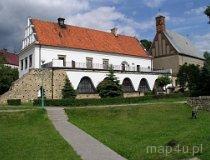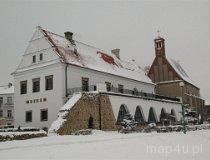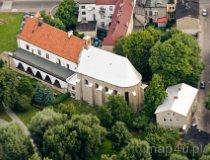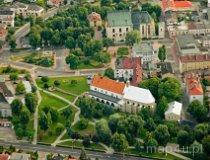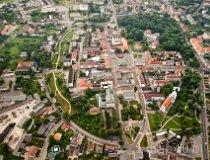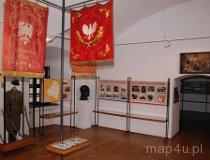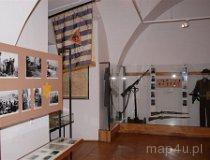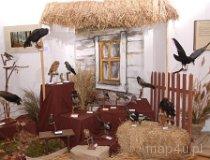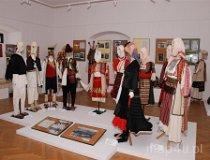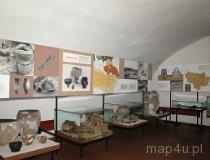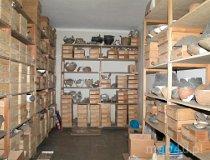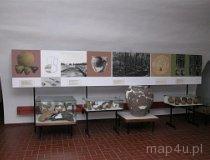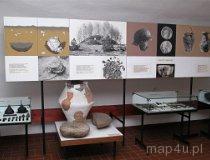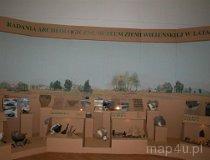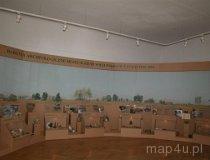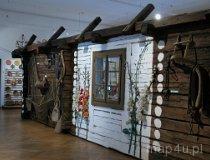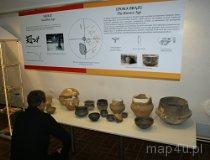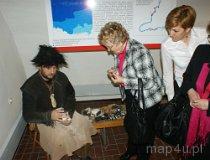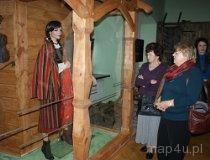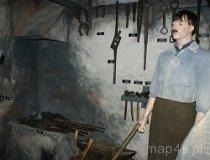The old monastery complex of Bernardine nuns – the Museum of the Region of Wieluń
Description
The main building of the old monastery is a single-storey structure with high roof covered with roof tiles. Original ceilings survived in the cellars. The remains of the old monastery and fragments of city walls adjoin the south side of the building.
The former Bernardine church (currently Evangelical) was founded by A. Koniecpolska and built in 1612-1615. It was renovated and reconstructed in the 17th-20th century. It is a brick building, single-naved and buttressed. The saddleback roof is topped with a brick turret. The elevation is ornamented with a sgraffito frieze.
Date or time of building
1616 r. (XVII w.)
Pierwsze muzeum w Wieluniu uruchomione zostało w 1926 r., w czasie II wojny światowej uległo zniszczeniu. Odtworzone zostało w obecnym miejscu w 1964 r.Date or time of building
1616
The first museum in Wieluń was opened in 1926. It was destroyed during the second world war and reopened in its current seat in 1964.
Building material
Rubble filled in with brick.
History
The monastery of Bernardine nuns was founded on the initiative of Anna Koniecpolska, the Sieradz voivode Aleksander Koniecpolski’s widow. The construction began in 1612. The monastery was consecrated in 1616.
Until the 19th century the monastery looked impressive thanks to generous donors and large dowries of gentlewomen who entered the convent. In 1819 the authorities decided to move the nuns to the building of the Pauline monastery. The church was given to the Evangelic commune and the monastery was sold to private owners and converted into a textile manufacture. During the world war the second the building held a carpenter’s workshop.
At present, the former monastery serves special purposes as the seat of the Museum of the Region of Wieluń established in 1926 by the Polish Education Society (it lost all its collection during the war).
After prolonged post-war renovation, in January 1964 the museum was reopened in the former monastery, mostly thanks to the efforts of Tadeusz Olejnik, who later became the director of the Museum of the Region of Wieluń.
Type of collection
The collection concerns mostly the history of the Region of Wieluń and includes archaeological finds (most of them were found by the museum employees during excavation works), historic items (postcards, photographs, medals, documents and a collection of weaponry) and ethnographic exposition (the furnishing of a peasant cottage, the traditional historical costume and modern folk art).
The permanent exhibition consists of three parts: the archaeological one (“The Prehistory of the Region of Wieluń”) concerning the history of the Region of Wieluń from the prehistory to the early Middle Ages and the history of Wieluń until the 19th century; the historical one (“The Participation of the Region of Wieluń in the Fight for the National and Social Liberation”) concerning the history from the January Uprising to the second world war (particular emphasis was placed on showing the destruction of the town on the 1st of September 1939); and the ethnographic one (“The everyday life of the Wieluń countryside in the beginning of the 20th century”) with the reconstruction of a narrow-fronted cottage, typical for the Region of Wieluń, a large collection of modern folk art from the region and Wieluń historical costumes.
Curious details
Anna Koniecpolska, neé Sroczyńska, the founder of the monastery which currently holds the museum, was a religious person who planned to enter the convent after her husband’s death. She decided to bring Bernardine nuns to Wieluń (originally, the nuns were supposed to be the Poor Clares or Barefoot Carmelites). The nuns came to Wieluń from Warsaw. Anna Koniecpolska not only founded the church and the monastery, but also bought lands near Wieluń, which became the remuneration for the nuns. The founder died in October 1616 and was buried in the vault of the church (currently the Evangelical church).
Form of legal protection
The entries in the regional heritage register:
- The old monastery complex of Bernardine nuns – the monastery, registry number: 970 from 1967-12-30.
- The old monastery complex of Bernardine nuns – the former Bernardine church, currently the Evangelical church, registry number: 969 from 1967-12-30.
Object location
The museum is located in the west part of the town centre, within the medieval city walls.
On Plan Legionów (150 m from the museum), there is a public bus stop.
Around 600 m to the north-east of the museum there is a bus station in Wieluń, from where buses depart to many local and regional destinations, as well as to some cities in Poland, including Łódź, Warsaw, Wrocław, Cracow, Katowice and Opole.
Around 900 m to the north-east of the museum there is a railway station in Wieluń, from where trains depart to Katowice (2 trains daily), Szczecin (2), Pątnów (2), Tarnowskie Góry (1), Kępno (1), Częstochowa (1) and Cracow (1).
Accessibility
The museum is open every day except Mondays (on Sundays the entrance is free).
Sources, links
Olejnik, T. Muzeum Ziemi Wieluńskiej. Dzieje, Zbiory, Działalność. 1964-1984. Warsaw-Łódź: PWN, 1987.
Abramek, B. Muzeum Ziemi Wieluńskiej 1964-2004. Wieluń: MZW, 2004.
Owner, manager
The Town Council of Wieluń
The Museum of the Region of Wieluń
director Jan Książek




